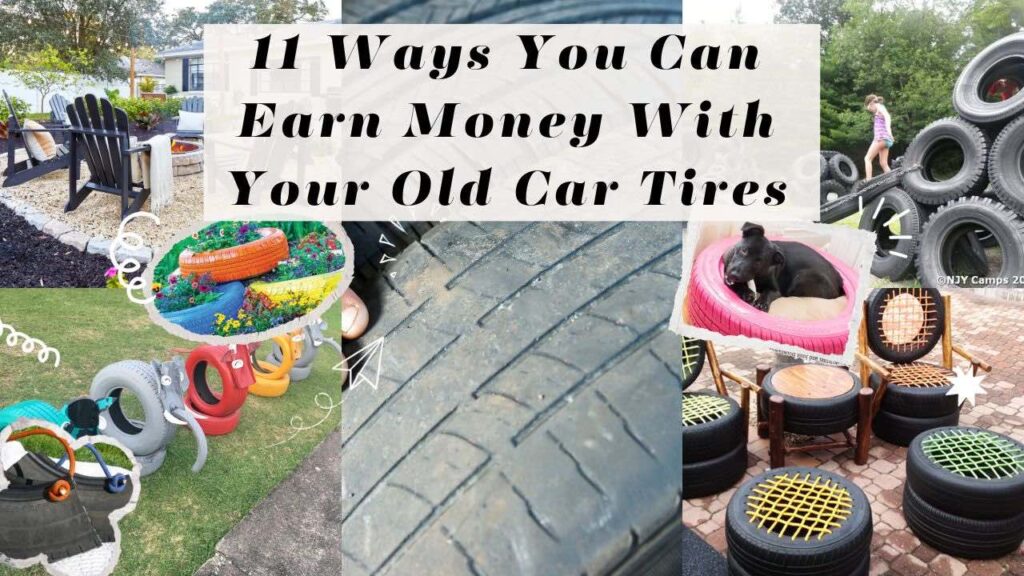
The business of earning money with old car tires involves finding creative and sustainable ways to repurpose or recycle used tires for financial gain.
This venture is part of the broader field of recycling and upcycling, contributing to environmental sustainability while generating income.
One spectacular thing about this business is; it is not limited to any country or region as it is profitable both in poor countries/regions and buoyant countries/regions.
In this article, we will be showing you 11 ways you can earn money with your old car tires.
1. Tire Recycling:
A tire recycling business is a venture dedicated to repurposing used tires, addressing environmental concerns while creating a sustainable source of income.
There are key components when it comes to establishing and operating a tire recycling business. They are:
- Collection of Old Tires
- Processing Stage
- Shredding Process
- Rubber Mulch Production
- Crumb Rubber Production
- Sale to Manufacturers
Manufacturers in industries such as construction, landscaping, and automotive are those who mostly utilize recycled rubber materials as cost-effective and sustainable alternatives to virgin rubber or traditional construction materials.
2. Art and Craft Products:
Converting used tires into art and craft products, such as tire planters, sculptures, furniture, and decorative pieces, for sale at local markets, fairs, or online platforms is an innovative and sustainable business idea that seamlessly combines creativity with environmental consciousness.
This initiative entails giving a new purpose to discarded tires by transforming them into visually appealing and functional items, resulting in a unique and eco-friendly product line.
3. Tire Sculptures:
Tire sculptures involve the artistic transformation of tires into visually appealing and unique artworks. Artists and entrepreneurs carve, shape, and assemble tires to create sculptures that can range from abstract pieces to intricate animal figures.
These sculptures cater to art enthusiasts, businesses, and public spaces seeking distinctive outdoor or indoor decor. The market potential extends to individuals looking for one-of-a-kind pieces that seamlessly blend creativity with sustainability.
Revenue in the tire sculptures business is generated through the sale of finished sculptures. Additionally, customized or commissioned pieces offer an avenue for higher-priced and personalized creations.
4. Playground Surfaces:
Shredded tire material is used to create soft surfaces for playgrounds, offering impact resistance and enhancing safety for children.
This involves processing tires into rubber mulch or crumb rubber.
Potential clients include schools, municipalities, and organizations responsible for playground construction or renovation.
Revenue in this upcycling business is generated by selling processed tire material for use in playground surfacing projects.
5. DIY Projects for Sale:
Creating and selling DIY kits allows individuals to undertake tire repurposing projects on their own.
Kits include instructions, materials, and tools necessary for crafting items like tire swings, planters, or decorative pieces.
DIY kits cater to a wide audience, from hobbyists and families to those interested in sustainable crafting.
Kits can be sold through online platforms, specialty stores, or at craft fairs. The business model also includes potential revenue from workshops or tutorial sessions.
6. Rubber Mulch:
Shredded tires are processed into rubber mulch, which serves as a sustainable alternative to traditional mulching materials.
Landscapers, garden centers, and homeowners seeking eco-friendly landscaping options are potential customers.
Revenue is generated by selling bulk rubber mulch to landscaping companies, garden centers, and individuals.
7. Tire Paving:
Tires can be cut into strips and used for paving walkways or driveways, offering a unique and environmentally conscious alternative to traditional paving materials.
Homeowners, landscape architects, and businesses with outdoor spaces seeking sustainable and visually interesting flooring solutions.
Revenue is generated not only through the sale of tire pavers but also by offering installation services.
8. Tire Weaving:
Tire weaving involves cutting tire treads into strips and weaving them to create functional items like doormats, baskets, or belts.
Products can be sold at craft markets, online platforms, or through collaborations with eco-friendly retailers.
Offering customization options enhances the appeal of tire-woven products, allowing customers to choose colors and patterns.
9. Tire Garden Beds:
Old tires can be transformed into raised garden beds, providing a cost-effective and durable solution for gardening enthusiasts.
Home gardeners, urban dwellers with limited space, and community gardening projects represent potential customers.
Garden beds can be sold directly to consumers, through gardening supply stores, or as part of community gardening initiatives.
10. Tire-derived Fuel (TDF):
Tire-derived Fuel (TDF) is a fuel derived from scrap tires, typically through a shredding process.
The resulting shredded material can be used as a supplemental fuel source in various industrial applications, such as cement kilns, pulp and paper mills, and power plants.
The processes involve:
- Collection
- Shredding
- Metal Separation
- Quality Control
The TDF is then sold and supplied to industries as an alternative fuel. Cement kilns, for example, can use TDF alongside traditional fuels like coal.
The energy content of TDF can be harnessed for heat generation in various manufacturing processes.
11. Tire Retreading:
Tire retreading is a sustainable practice that involves extending the lifespan of a tire by replacing its worn-out tread with a new one.
This process contributes to resource conservation, cost savings, and reduced environmental impact.
Tire retreading operations adhere to industry standards and regulations to guarantee the safety and performance of retreaded tires.
Compliance with these standards ensures that retreaded tires meet or exceed the performance of new tires.
This makes tire retreading a practical choice for both individuals and businesses with substantial fleets, offering cost savings in comparison to the purchase of new tires.
READ ALSO:
- How to Start a Car Dealership Business: Your Guide to Starting the Car Selling Business
- How to Make Money Selling Vehicle Tyres in Nigeria
- How to Start Engine Oil Business in Nigeria as a Successful Seller
- How to Start Automobile( Keke Napep, Car, Truck) Spare Parts Business
Conclusion
Before pursuing any of these options, it’s important to consider local regulations regarding the disposal and repurposing of tires.
Some regions have specific guidelines for handling used tires to ensure environmental and safety standards are met.
Additionally, exploring local markets, online platforms, and eco-friendly communities can help you find potential buyers for your recycled and upcycled tire products.
Discover more from StartBizEasy
Subscribe to get the latest posts to your email.





